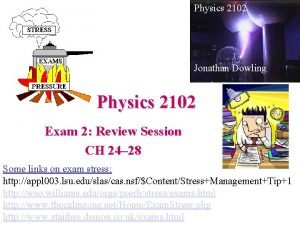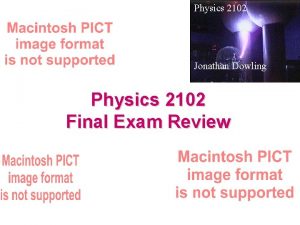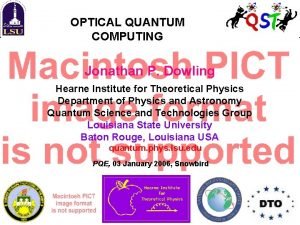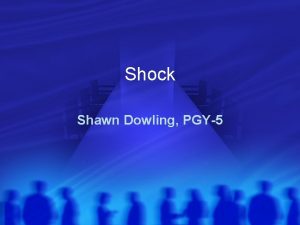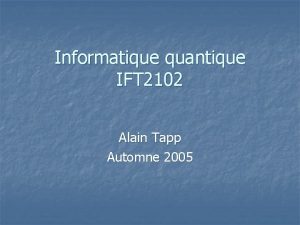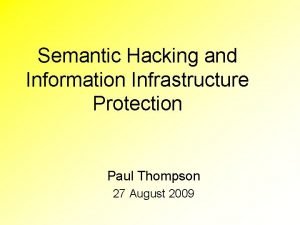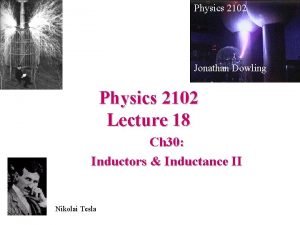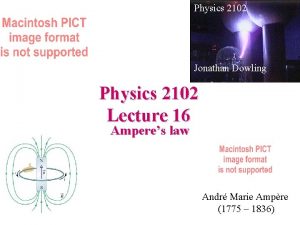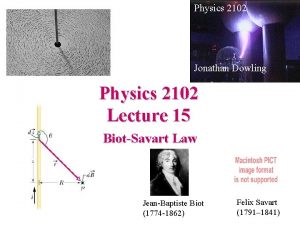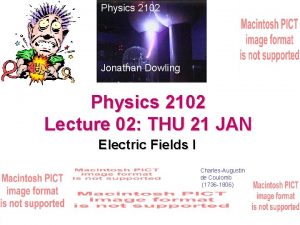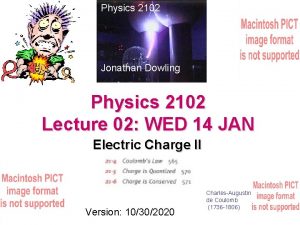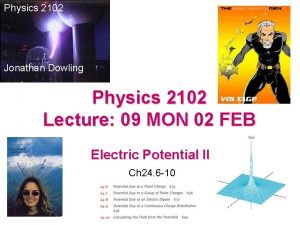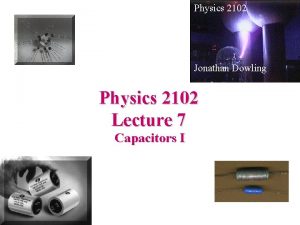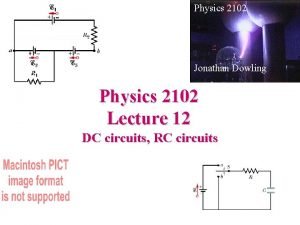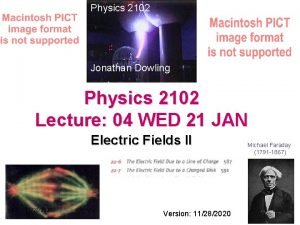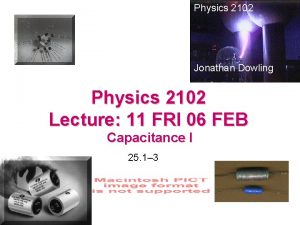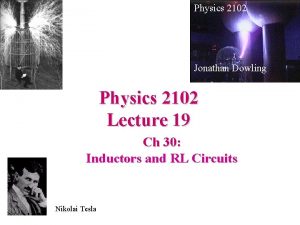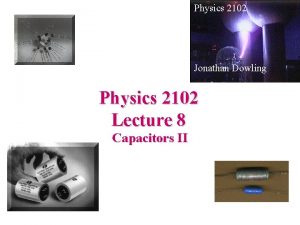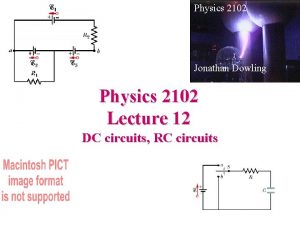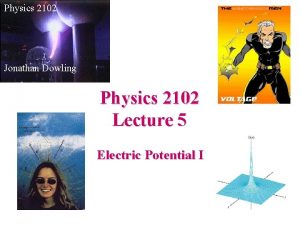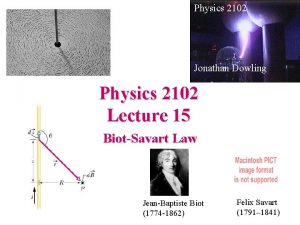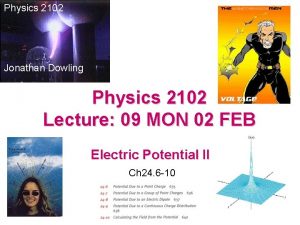Physics 2102 Jonathan Dowling Physics 2102 Lecture 2
























- Slides: 24

Physics 2102 Jonathan Dowling Physics 2102 Lecture 2 Electric Fields 11/26/2020 Version: 1/17/07 Charles-Augustin de Coulomb (1736 -1806)

What are we going to learn? A road map • Electric charge Electric force on other electric charges Electric field, and electric potential • Moving electric charges : current • Electronic circuit components: batteries, resistors, capacitors • Electric currents Magnetic field Magnetic force on moving charges • Time-varying magnetic field Electric Field • More circuit components: inductors. • Electromagnetic waves light waves • Geometrical Optics (light rays). • Physical optics (light waves)

Coulomb’s law For charges in a VACUUM k= Often, we write k as:

Electric Fields • Electric field E at some point in space is defined as the force experienced by an imaginary point charge of +1 C, divided by 1 C. • Note that E is a VECTOR. • Since E is the force per unit charge, it is measured in units of N/C. • We measure the electric field using very small “test charges”, and dividing the measured force by the magnitude of the charge. Electric field of a point charge +1 C q E R

Superposition • Question: How do we figure out the field due to several point charges? • Answer: consider one charge at a time, calculate the field (a vector!) produced by each charge, and then add all the vectors! (“superposition”) • Useful to look out for SYMMETRY to simplify calculations!

Example Total electric field -2 q +q • 4 charges are placed at the corners of a square as shown. • What is the direction of the electric field at the center of the square? -q y +2 q (a) Field is ZERO! (b) Along +y (c) Along +x x

Electric Field Lines • Field lines: useful way to visualize electric field E • Field lines start at a positive charge, end at negative charge • E at any point in space is tangential to field line • Field lines are closer where E is stronger Example: a negative point charge — note spherical symmetry

Electric Field of a Dipole • Electric dipole: two point charges +q and –q separated by a distance d • Common arrangement in Nature: molecules, antennae, … • Note axial or cylindrical symmetry • Define “dipole moment” vector p: from –q to +q, with magnitude qd Cancer, Cisplatin and electric dipoles: http: //chemcases. com/cisplat 01. htm

Electric Field ON axis of dipole -q a +q P x

Electric Field ON axis of dipole p = qa “dipole moment” -- VECTOR - + What if x>> a? (i. e. very far away) E~p/r 3 is actually true for ANY point far from a dipole (not just on axis)

Electric Dipole in a Uniform Field • Net force on dipole = 0; center of mass stays where it is. • Net TORQUE t: INTO page. Dipole rotates to line up in direction of E. • | t | = 2(QE)(d/2)(sin q) = (Qd)(E)sinq = |p| E sinq = |p x E| • The dipole tends to “align” itself with the field lines. • What happens if the field is NOT UNIFORM? ? Distance between charges = d

Electric charges and fields We work with two different kinds of problems, easily confused: • Given certain electric charges, we calculate the electric field produced by those charges (using E=kqr/r 3 for each charge) Example: the electric field produced by a single charge, or by a dipole: • Given an electric field, we calculate the forces applied by this electric field on charges that come into the field, using F=q. E Examples: forces on a single charge when immersed in the field of a dipole, torque on a dipole when immersed in an uniform electric field.

Continuous Charge Distribution • Thus far, we have only dealt with discrete, point charges. • Imagine instead that a charge Q is smeared out over a: Q Q – LINE – AREA – VOLUME • How to compute the electric field E? ? Q Q

Charge Density l = Q/L • Useful idea: charge density • Line of charge: charge per unit length = l • Sheet of charge: charge per unit area = s • Volume of charge: charge per unit volume = r s = Q/A r = Q/V

Computing electric field of continuous charge distribution • Approach: divide the continuous charge distribution into infinitesimally small elements • Treat each element as a POINT charge & compute its electric field • Sum (integrate) over all elements • Always look for symmetry to simplify life!

Example: Field on Bisector of Charged Rod • Uniform line of charge +Q spread over length L • What is the direction of the electric field at a point P on the perpendicular bisector? (a) Field is 0. (b) Along +y (c) Along +x • Choose symmetrically located elements of length dx • x components of E cancel P y a x dx o L dx q

Example --Line of Charge: Quantitative • Uniform line of charge, length L, total charge Q • Compute explicitly the magnitude of E at point P on perpendicular bisector • Showed earlier that the net field at P is in the y direction -- let’s now compute this! P y a x o L Q

Line Of Charge: Field on bisector Distance d. E P Charge per unit length a d dx x o L Q

Line Of Charge: Field on bisector What is E very far away from the line (L<<a)? What is E if the line is infinitely long (L >> a)?

Example -- Arc of Charge: Quantitative • Figure shows a uniformly charged rod of charge -Q bent into a circular arc of radius R, centered at (0, 0). • Compute the direction & magnitude of E at the origin. y 450 x y d. Q = l. Rdq dq q x l = 2 Q/(p. R)

Example : Field on Axis of Charged Disk • A uniformly charged circular disk (with positive charge) • What is the direction of E at point P on the axis? z (a) Field is 0 (b) Along +z (c) Somewhere in the x-y plane P y x

Example : Arc of Charge y • Figure shows a uniformly charged rod of charge -Q bent into a circular arc of radius R, centered at (0, 0). • What is the direction of the electric field at the origin? x (a) Field is 0. • Choose symmetric elements (b) Along +y • x components cancel (c) Along -y

Summary • The electric field produced by a system of charges at any point in space is the force per unit charge they produce at that point. • We can draw field lines to visualize the electric field produced by electric charges. • Electric field of a point charge: E=kq/r 2 • Electric field of a dipole: E~kp/r 3 • An electric dipole in an electric field rotates to align itself with the field. • Use CALCULUS to find E-field from a continuous charge distribution.

 Jonathan dowling
Jonathan dowling Jonathan dowling
Jonathan dowling Dowling optical
Dowling optical Dowling roundabout
Dowling roundabout International human resource management dowling 6th edition
International human resource management dowling 6th edition Shock mnemonic
Shock mnemonic 01:640:244 lecture notes - lecture 15: plat, idah, farad
01:640:244 lecture notes - lecture 15: plat, idah, farad Nutrition 2102
Nutrition 2102 Nutrition 2102
Nutrition 2102 Sos.texas.gov form 2102
Sos.texas.gov form 2102 Ift-2102
Ift-2102 Nutrition 2102
Nutrition 2102 Physics 111 lecture notes
Physics 111 lecture notes Atmospheric physics lecture notes
Atmospheric physics lecture notes Physics 101 lecture notes pdf
Physics 101 lecture notes pdf Physics 101 lecture notes pdf
Physics 101 lecture notes pdf Phy101 lecture 1
Phy101 lecture 1 Physics waves notes pdf
Physics waves notes pdf Ib physics ia ideas
Ib physics ia ideas Why does it happen
Why does it happen University physics with modern physics fifteenth edition
University physics with modern physics fifteenth edition Dr jonathan meek
Dr jonathan meek Jonathan janus
Jonathan janus Angry similes
Angry similes Jonathan lebed
Jonathan lebed
